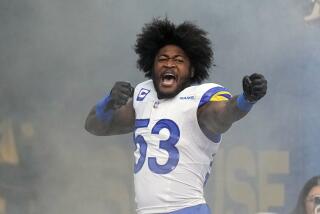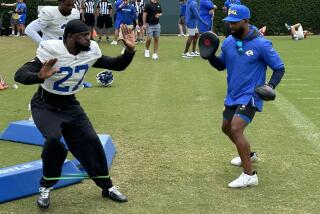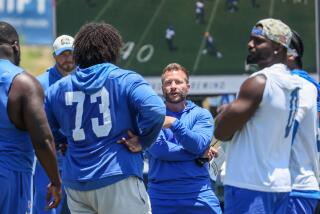Rushing Him Out of Town
More often than not, Ram forays into the first round of the NFL draft have produced darkness, not Lyght, as we are reminded again while bidding adieu to Gaston Green, the fabled sitting running back of the Anaheim Stadium sidelines.
Green made his exit Sunday, only hours after Todd Lyght arrived. On another day, it would have turned a few headlines-- Rams Trade Former No. 1 --but amid the exultation and adulation over the selection of Lyght, Green got lost in the shuffle.
No news there. That’s how it always was with Green and the Rams, from the first day they spent together.
If Green hadn’t been lost in the shuffle, he wouldn’t have gotten any action at all.
Green was a Ram for three years, or 48 regular-season games. In that time he rushed 129 times for 451 yards. That’s an average of 2.7 carries a game, 9.4 yards a game.
Green’s best season with the Rams was 1990, which was John Robinson’s worst season as a Ram, which was no coincidence. Robinson didn’t want to play Green, but he soon found himself with no choice, not with Cleveland Gary spraying footballs all over the field and Curt Warner requesting that his rushing average be calculated in inches.
So Green played and Robinson reluctantly allowed him 68 carries. Green used them to gain 261 yards.
Five more and he would have matched his total for the 1986 Freedom Bowl.
The Rams will remember Green as their hitless wonder--something to behold until a defender got ahold of him. Green can run like the wind until the wind changes direction. Then, the wind makes the tackle, unassisted.
Robinson couldn’t stand to play Green because he couldn’t bear to watch. Where Eric Dickerson and Charles White once ran over the men they couldn’t run around, Green stumbled over cleat marks in the turf. He was half a halfback in Robinson’s mind--a runner, but no hitter--and given a choice, Robinson would have easily opted for the other half.
For more than a year, Robinson wanted to trade Green. One thing about trades, though: First, you need someone to trade with. Robinson had to wait until the Denver Broncos fell apart, finished 4-12, got desperate--and then asked the Rams to sweeten the pot.
Finally, a deal was struck.
Denver would get Green and the higher of the Rams’ two fourth-round draft picks.
The Rams would get a 12th-round pick and an offensive lineman, Gerald Perry, whose next uniform number could be six digits long.
You might have heard or read the news accounts: “The much-troubled Gerald Perry.” How troubled? In Denver, they began keeping score on Perry and so far he’s ahead, 3-2, acquittals over convictions, with two charges still pending.
The acquittals: An alleged rape of a 25-year-old woman at gunpoint and two charges of assault.
The convictions: Two counts of soliciting a prostitute.
Still pending: An alleged third-degree sexual assault and an alleged attack on one Johnathon Bell, who once testified on Perry’s behalf during one of the acquittals.
When the Rams finalized the trade, their public relations staff distributed rap sheets on Perry--photocopies of a newspaper clipping that chronicled Perry’s off-the-field problems since joining the Broncos. The copy is set in agate type, one column in width, and runs nearly a foot long.
It ends with this notation:
Nov. 30, 1990--Perry is acquitted on assault charges, then announces he is quitting football.
Three months later, Perry held a press conference to announce his un-retirement, to apologize and to basically attempt to salvage his relationship with the Broncos. Too late. At the time of the trade, Perry was on the Broncos’ “Reserve--Left Squad” list, where he expected to stay until the team could roust up a taker.
The reaction to the trade in Denver was predictable, considering that before the trade, columnists were calling for Coach Dan Reeves’ dismissal because he hadn’t already released Perry. One columnist called it a great trade, writing that “a trade for nothing” would have been a good one.
Denver really doesn’t have any use for Green--the Broncos already have Bobby Humphrey and drafted a potential backup, Greg Lewis of Washington--but that’s beside the point. The Broncos were shedding baggage, pure and simple. If Green returns a few kickoffs or the fourth-rounder pans out, it’s gravy.
The Rams, meanwhile, were left with questions.
Can Perry play?
Yes, the scouting reports say. Perry is only 27, has played in a Super Bowl and was a Bronco starter until the middle of the 1990 season, when his days in court began to outnumber his days on the practice field. “That fourth-rounder better be a Pro Bowler,” said one Bronco official, “because Gerald will start for them. He’s a real player. A stud.”
Will Perry play?
No coach’s decision here. That will be determined by a higher authority, in June, when Perry has court dates for the sexual assault charge and the alleged assault on Bell. If Perry’s lawyers bat a mere .500, Perry will be in a cellblock before he delivers his first Ram block.
Was Robinson really kidding when he said, “We’ve got too many nice guys, we need some discipline problems” after drafting UCLA linebacker Roman Phifer? Phifer sat out his junior season after getting suspended for hitting a campus security officer and urinating on his car.
Now Perry is aboard and, judge and jury willing, he soon will be hitting people, legally, as a member of the Ram offensive line.
If imitation is the sincerest form of flattery, Al Davis must be drawing immense satisfaction from all of this.
Thirty-five miles down the freeway, the Raiderfication of Anaheim’s Rams is now under way.
More to Read
Go beyond the scoreboard
Get the latest on L.A.'s teams in the daily Sports Report newsletter.
You may occasionally receive promotional content from the Los Angeles Times.










